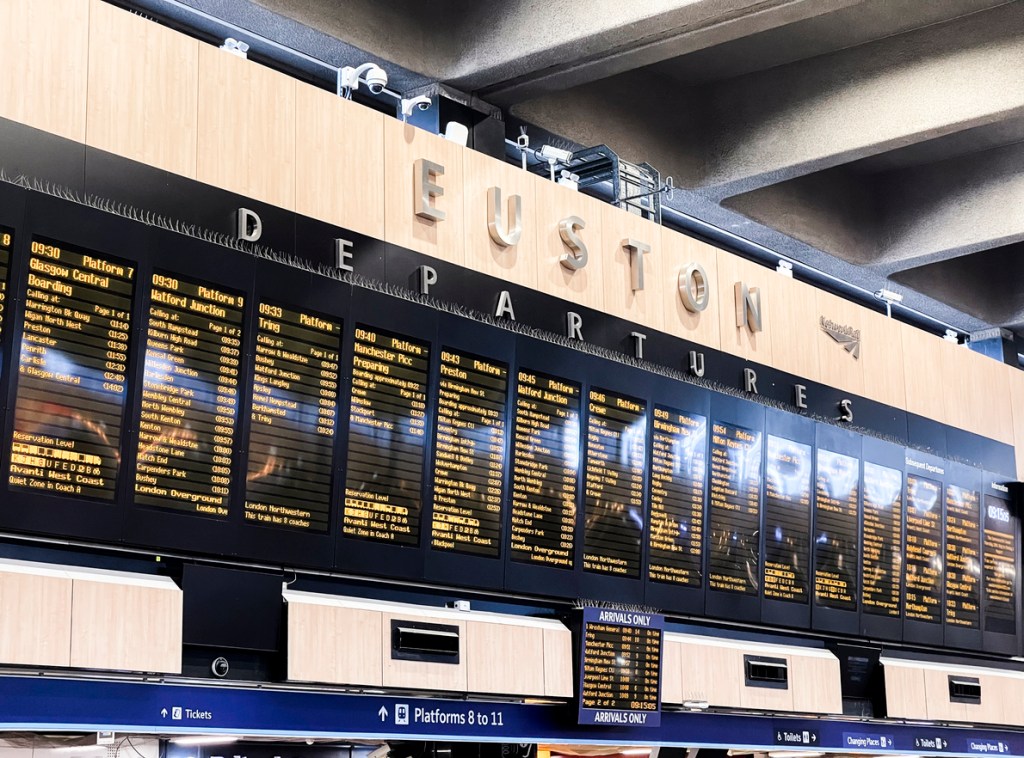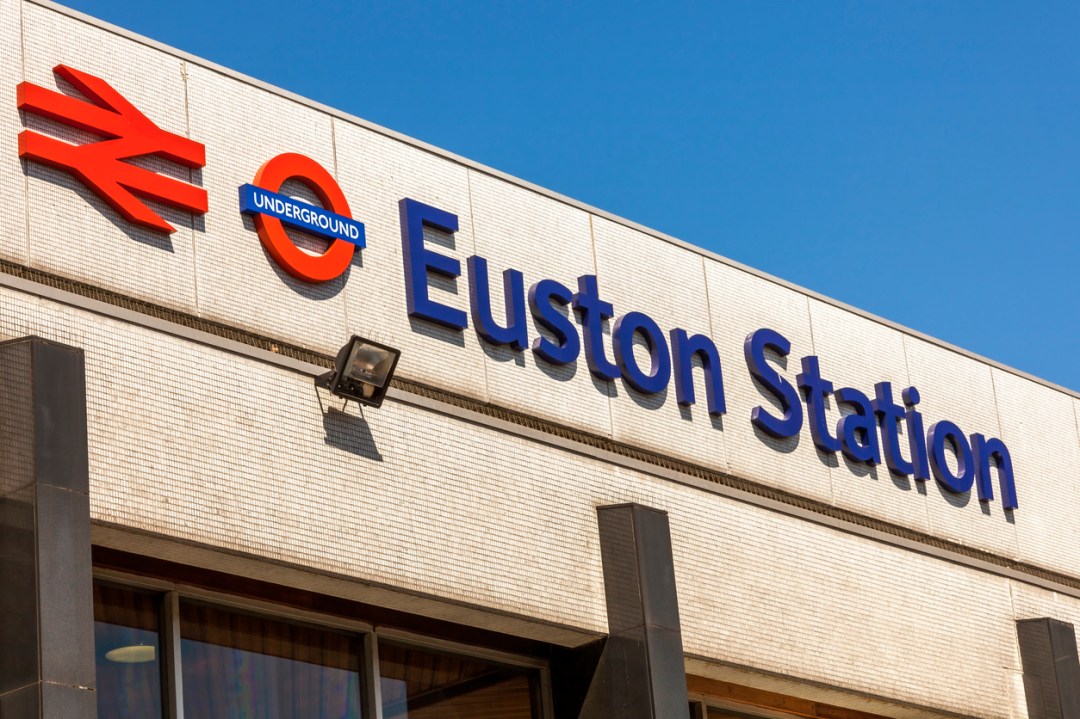Euston Station has been in the news again, and that’s never good. After a summer of overcrowding and delays, public anger forced the Transport Secretary, Louise Haigh, to intervene last week, shutting down the monstrous, flashing digital advertising screen that spans the concourse and which has made passengers feel like battery hens trapped in a seizure-inducing neurological experiment. A ‘five-point plan’ of further improvements is promised, but no one believes it’ll work. This is Euston. It’s irredeemable. Everyone – just everyone – hates Euston.
This has always been a station with its sleeves rolled up and serious work to do
Well, I don’t. I hate what they’ve done to it, sure. I detest the lazy excuses, the neglect, and the tawdry retail outlets. Perhaps I’d feel differently if I used it daily. But I did commute for a decade through its Stygian half-sister, Birmingham New Street; and these days I pass through Euston two or three times a week, so I have a certain amount of skin in the game. And I’ve come to feel that we’re getting Euston wrong – badly wrong. I’ve realised that, with all its flaws, I actually love London Euston.
Part of it is tied up with the romance of travel. I’m a West Coast Main Line kid; I’ve spent most of my life in the North West and the Midlands. Euston has always been my portal to the capital – the place where new adventures start and the surest escape route when, inevitably, they go wrong. Even today, there’s a drama in arriving at Euston: the distant arch of Wembley, the stately descent through those Victorian canyons of stone and brick. And then the first glimpse of the station throat – the fan of platforms with inter-city trains poised at their heads, ready to speed off to Glasgow or Liverpool or Holyhead. Pulling into Euston is like being plugged into the nerve-centre of the nation.

True, the platforms aren’t pretty. They never were, even in the steam age; this has always been a station with its sleeves rolled up and serious work to do. There’s a realness and toughness about Euston that’s worlds away from the redeveloped St Pancras, with its twee boutiques and all the actually-useful trains banished to a barren annexe that’s already halfway to Kettering. No champagne bars here, though it speaks volumes that the two best pubs in any London railway station – proper boozers, places where you can linger over a pint – are at Euston: the Euston Tap and the Doric Arch.
And once you’re onto the concourse – well, I’ll agree, first impressions are not great. Euston these days is hectic, dysfunctional and grubby. But of course it is: welcome to London! A great station – whether Rome’s Stazione Termini or Mumbai’s Chhatrapati Shivaji Terminus – embodies its city. The slightly unhinged loathing that many Londoners seem to feel for Euston has something about it of the rage of Caliban seeing his face in a glass.
Regardless, the heart sinks. But then it starts to soar. Next time you’re waiting for your platform to be announced, look around and see what Euston is, what it was, and what it could be. Gaze up at the huge vaulted roof (ignore the neglect that has turned it beige). The great cupola seems to hover above the concourse, and daylight streams in from all sides – at least it did, until a crude mezzanine was crowbarred in a couple of decades back. Look down at the gorgeous pavement, with its swirling, faux-marble tiles (apparently they’re made of serpentinite and green concrete). They haven’t worn at all since the current station was opened in 1968. In fact – like the floor of some renaissance palazzo – they’re growing more beautiful with age.
Pop into the ticket office, where the playful eggbox of a 1960s ceiling was carefully restored a few years ago, to very little appreciation. If it was in the Barbican or the Southbank they’d call it iconic. Then step outside and take a proper look at the exterior: that broad, elegant low-rise pavilion with its noble anchoring colonnade clad in polished black granite. Admittedly, it’s hard to get a perspective because it’s hemmed in by tacky later developments. Supermarkets and burrito stalls have clogged the classical purity that its designers intended. They imagined a glass-walled agora; we’ve ended up with Dum Dum doughnutterie.
But for anyone with eyes to see, it’s obvious that the insults levelled at Euston’s architecture are very wide of the mark. This is no brutalist fist in the face of the passenger; no utilitarian concrete box. It’s a modernist expression of the Greek Revival tradition. Euston Station is human in scale. It’s classically proportioned, respectful of the cityscape around it and lovingly detailed and finished by people who believed, sincerely and unironically, that the travelling public – and the nation’s capital – deserved infrastructure that is both useful and beautiful.
It never stood a chance, of course. Euston was doomed from birth to be slandered and misused. It carries the architectural version of Original Sin: the oh-so-1960s arrogance that insisted that the station’s 19th-century Great Hall and Doric Arch shouldn’t be remodelled, but utterly obliterated. I get that. Look, I’m a reactionary to the bone. If a genie emerged from a discarded Coke can on one of those fetid forecourt picnic tables, I’d wish for the return of steam, the reversal of the Beeching cuts and the restoration of the Austro-Hungarian monarchy.
Just know that the Arch wasn’t on Euston Road, as many seem to think. It was roughly where the station’s branch of Burger King is located today. If you think overcrowding at Euston is bad now, it’s impossible not to concede that it needed rebuilding then. Obviously, like all right-thinking people, I hope that a more sympathetic future redevelopment will see the Arch restored (though not, ideally, outside Burger King).
But I also hope that the 1968 building will finally get the care that it deserves – that the neglect is reversed and the excrescences stripped away so the beauty and functionality of this great postwar terminus can sing once more: spacious, airy and dignified. I’m old enough to remember when Victorian Gothic, too, was regarded as hideous and impractical. Euston, imaginatively refurbished, could be a modernist counterpart to St Pancras – and quite a bit more usable. Some hope. Plenty of people will crow and cheer if – when? – those elegant columns are smashed to rubble and that beautiful floor is prised up and thrown into skips. But I won’t be among them.
This article is free to read
To unlock more articles, subscribe to get 3 months of unlimited access for just $5








Comments
Join the debate for just £1 a month
Be part of the conversation with other Spectator readers by getting your first three months for £3.
UNLOCK ACCESS Just £1 a monthAlready a subscriber? Log in